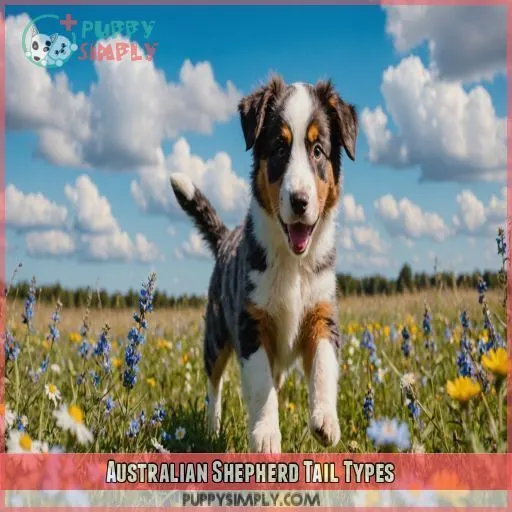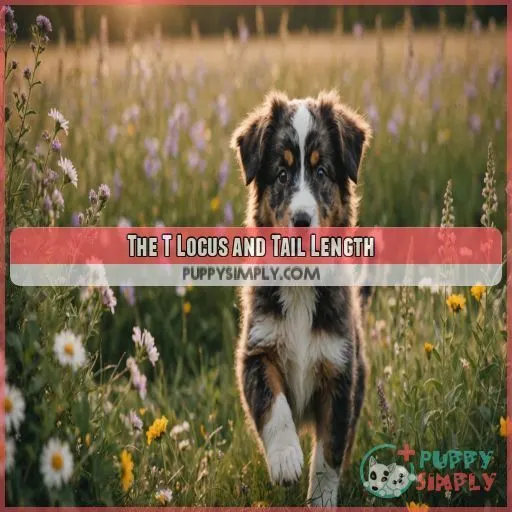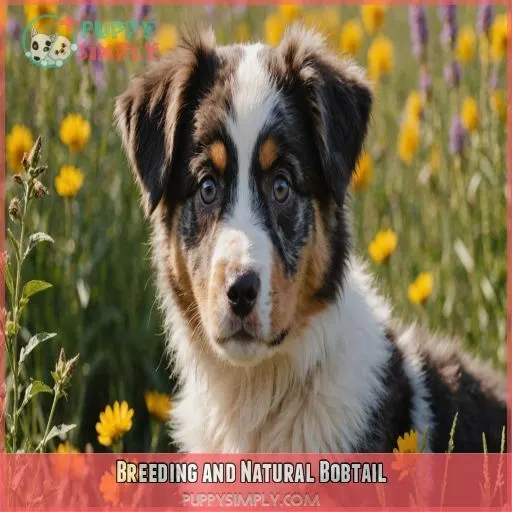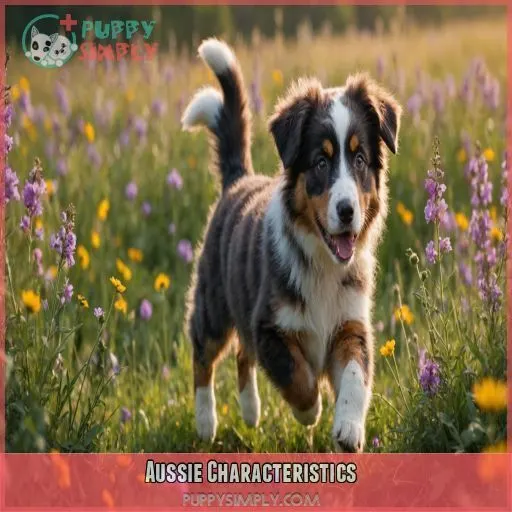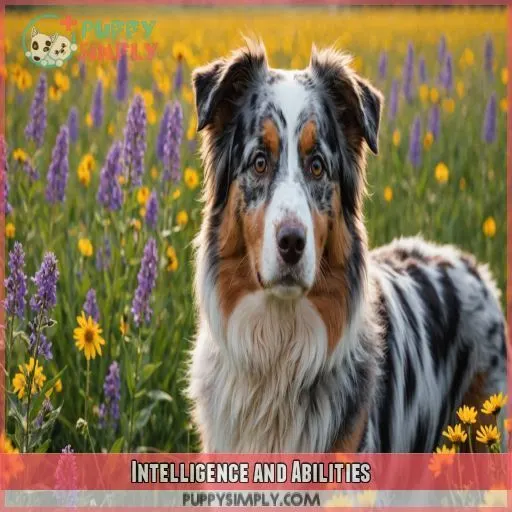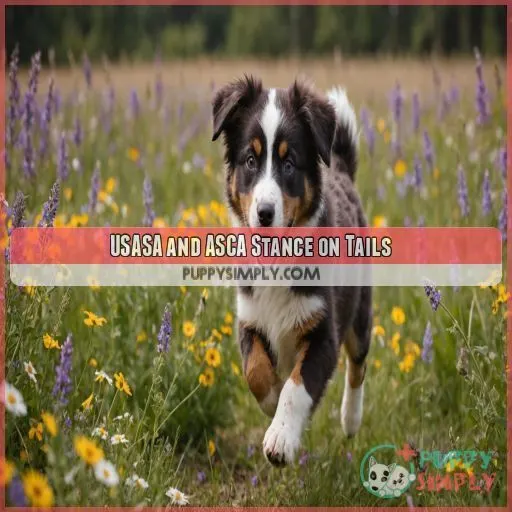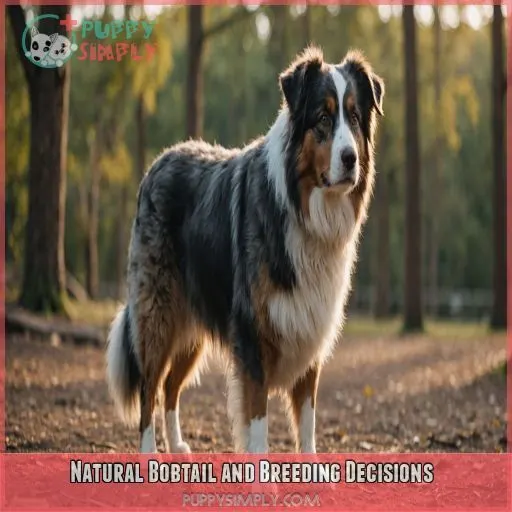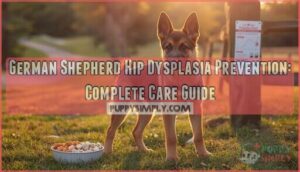This site is supported by our readers. We may earn a commission, at no cost to you, if you purchase through links.
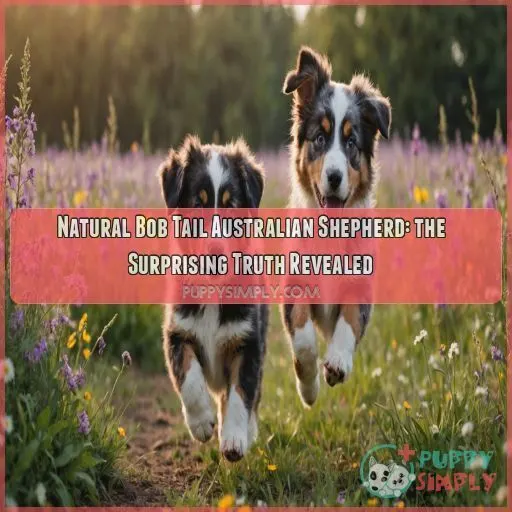 You’re curious about the Natural Bob Tail Australian Shepherd!
You’re curious about the Natural Bob Tail Australian Shepherd!
Well, let’s get straight to it – these dogs are born with a naturally short tail, determined by genetics, not surgical docking.
It’s a pretty cool trait, but you need to understand the genetics behind it to make informed breeding decisions.
The T Locus gene plays a significant role in determining tail length, and breeding for natural bobtails requires careful consideration of the potential health risks.
Want to know more about the fascinating world of Aussie genetics and how it affects their tail length?
There’s more to the story!
Table Of Contents
- Key Takeaways
- Australian Shepherd Tail Types
- The T Locus and Tail Length
- Natural Bobtail Genetics
- Breeding and Natural Bobtail
- Testing for Natural Bobtail
- Australian Shepherd History
- Aussie Characteristics
- Intelligence and Abilities
- USASA and ASCA Stance on Tails
- Natural Bobtail and Breeding Decisions
- Frequently Asked Questions (FAQs)
- Do Australian Shepherds have naturally bobbed tails?
- How to tell if a dog has a natural bobtail?
- How do you tell the difference between a docked tail and a natural bob?
- What is the bobtail gene in dogs?
- Can natural bobtail Aussies still compete in dog shows?
- How does natural bobtail affect an Aussies balance and agility?
- Are natural bobtail Australian Shepherds more prone to health issues?
- Can I breed a natural bobtail Aussie with a docked Aussie?
- Do natural bobtail Aussies require special grooming or care?
- Conclusion
Key Takeaways
- Did you know that some Aussies are born with a built-in fashion statement? Natural bobtails are like the supermodels of the dog world – they’ve got that effortlessly chic look without even trying! Just remember, it’s all in the genes, not a trip to the groomer.
- Breeding for natural bobtails is like playing genetic roulette. You’ve got to be careful not to double down on those dominant T alleles, or you might end up with a smaller litter than you bargained for. It’s all about finding that perfect balance, like a tightrope walker at the circus.
- Aussies are more than just a pretty face (and tail). These brainy pups are the Swiss Army knives of the dog world – from herding sheep to competing in frisbee tournaments, there’s nothing these furry polymaths can’t do. Talk about overachievers!
- When it comes to tails, the USASA and ASCA are like protective parents – they want what’s best for the breed. They’re all about embracing those natural bobtails while giving a respectful nod to tradition. It’s like walking a tightrope between the past and the future of Aussie breeding.
Australian Shepherd Tail Types
You’re probably wondering what makes an Australian Shepherd’s tail so unique – is it a natural bobtail or a docked tail? Let’s get to the bottom of it and explore the fascinating world of Aussie tail types, where you’ll learn how to identify a natural bobtail and understand its breeding implications.
Natural Bobtail Vs Docked Tail
Hey there, fellow Aussie enthusiasts! Let’s get real about Australian Shepherd tail types. You’ve got two main options: natural bobtail and docked tail. While some swear by the traditional docked look, others prefer the natural, untouched bobtail. Breed standards often dictate tail length preferences, but you need to think about the ethical implications and health concerns surrounding tail docking (Source).
How to Identify a Natural Bobtail
Identifying a natural bobtail in an Australian Shepherd is a breeze. Just remember, it’s not about the length, but the genetic code. Here are the key identifiers:
- Tail length variation: Natural bobtails can range from nearly full-length to virtually no tail
- Bobtail vs docked: A natural bobtail is different from a surgically docked tail
- Aussie tail types: Know the differences between natural bobtails and other tail variations in the breed
Breeding Implications of Natural Bobtail
Now that you know how to identify a natural bobtail, let’s talk about breeding implications.
As an Australian Shepherd breeder, you’ll want to keep in mind the genetics of natural bobtail inheritance to make sure your litters are healthy.
Responsible breeding practices are key to avoid passing on unwanted traits, like spina bifida, and to maintain breed standards while minimizing the need for tail docking.
The T Locus and Tail Length
You’re about to uncover the fascinating world of genetic tail-length determination in Australian Shepherds, where the T Locus plays a big role in deciding whether your Aussie will have a natural bobtail or a full-length tail. Understanding how the T Locus works will help you make informed decisions about breeding and make sure you’re not surprised by the tail length of your Aussie puppies (Source).
Dominant and Recessive Alleles
Let’s talk genes! You’re probably wondering how the T locus affects your Australian Shepherd’s tail length. It all comes down to dominant and recessive alleles. Here are the basics:
- The T allele is dominant, causing a natural bobtail.
- The t allele is recessive, resulting in a normal tail length.
- A dog can be heterozygous (Tt) or homozygous (TT or tt).
- Allele expression determines the tail length phenotype.
Genotype and Phenotype Explained
So, you want to understand how genotype and phenotype work in Australian Shepherds?
Think of genotype as the genetic recipe and phenotype as the final dish.
The T Locus determines tail length, with two alleles: T (dominant) and t (recessive) (Source).
The combination of these alleles creates the genotype, which then expresses the phenotype – either a natural bobtail or a normal tail length .
Lethal Genotype and Its Consequences
Now that you know how genotype and phenotype work, let’s talk about the lethal genotype and its consequences. If a puppy inherits two copies of the dominant T allele (T/T genotype), it won’t survive to birth. This has significant implications for breeding practices.
- Reduced litter size: Breeding two heterozygotes can lead to a 25% reduction in litter size.
- Ethical considerations: Breeders must weigh the risks of breeding for natural bobtails against the potential benefits.
- Future research: More studies are needed to understand the genetic diversity of Australian Shepherds and the implications of breeding for specific traits.
- USASA guidelines: The United States Australian Shepherd Association provides breed standards and guidelines for responsible breeding practices.
Natural Bobtail Genetics
You’re about to discover the fascinating world of natural bobtail genetics, where a single gene can determine whether your Australian Shepherd is born with a short, adorable tail or a longer one. So, let’s get started and explore how this autosomal dominant trait works, and what it means for your furry friend’s unique appearance.
Autosomal Dominant Inheritance
natural bobtail is an autosomal dominant trait, meaning a single copy of the gene is enough to express it. This is why pedigree analysis and carrier identification are really important in breeding. Don’t worry, it’s not a genetic disorder, but rather a quirk of nature that makes your Aussie unique. Think of it as a genetic superpower!
Variations in Bobtail Length
Talking about natural bobtails, did you know that the length can vary? Yep, it’s not just a one-size-fits-all trait! The length of the bobtail can range from nearly full-length tails to virtually no tail at all. Here are some fun facts about natural bobtail variations:
- Short and sweet: Some natural bobtails are super short, while others are a bit longer.
- Mid-range magic: Many natural bobtails fall somewhere in between short and long.
- Full-length flyers: Some natural bobtails can be nearly as long as a regular tail.
- What’s in between: The variation in bobtail length can be influenced by other genetic factors, but we’ll get to that later!
Influence of Other Genetic Factors
You’re learning about the intricacies of natural bobtail genetics! Other genetic factors can influence the length and expressiveness of your Aussie’s bobtail. It’s not just a simple on/off switch – genetics is complex! Think of it like a recipe, where genetic diversity and environmental influences are the secret ingredients that shape the final phenotype, making each dog unique.
Breeding and Natural Bobtail
You’re probably wondering how breeding affects the natural bobtail trait in Australian Shepherds. As you consider bringing a new furry friend into your life or breeding your own Aussie, understanding the genetics behind this unique characteristic can help you make informed decisions.
Predicting Tail Length in Offspring
predicting tail length in Aussie offspring is an art and science. By understanding the T Locus and genotype prediction, you can bypass the guessing game and breed with confidence.
Here’s how:
- Bobtail inheritance: a natural bobtail is caused by a dominant allele (T).
- T Locus impact: two copies of the dominant T allele (T/T) are lethal.
- Genotype prediction: knowing the genotype helps predict tail length variations in offspring.
Breeding Heterozygotes and Litter Size
Breeding heterozygotes (one natural bobtail and one normal tail) can be a roll of the dice.
Since each parent can pass on either gene, you’ve got a 25% chance of normal tails, 50% chance of natural bobtails, and 25% risk of lethal genotype.
Don’t worry, we’ll get to that later.
But, it also means reduced litter size – something to keep in mind when breeding.
Avoiding Lethal Genotype in Breeding
When breeding Australian Shepherds, it’s important to avoid the lethal genotype that results from two natural bobtail parents. Don’t risk losing 25% of your litter! Instead, pair a natural bobtail with a normal-tailed Aussie to make sure healthy pups. Responsible breeding is all about making informed choices that prioritize genetic diversity and the well-being of your dogs.
Testing for Natural Bobtail
You’re about to uncover the important role of genetic testing in determining if your Australian Shepherd has a natural bobtail.
This information is a game-changer for responsible breeding practices.
By exploring the ins and outs of DNA testing for the bobtail gene, you’ll gain a deeper understanding of your furry friend’s unique characteristics.
You’ll also learn how to make informed decisions about their health and well-being.
DNA Testing for Bobtail Gene
You want to uncover the secrets of your Australian Shepherd’s bobtail.
DNA testing for the bobtail gene is the answer.
You’ll want to think about the ethical implications, testing accuracy, and cost-benefit analysis before making a decision.
By doing so, you’ll be promoting genetic diversity and responsible breeding practices.
Get ready to discover the truth about your furry friend’s unique feature!
Testing Procedure and Requirements
So you’re ready to test your Aussie for the natural bobtail gene. To collect a sample, you’ll need a cytology brush provided by the lab or purchase one yourself. Make sure your dog hasn’t eaten or drunk for at least an hour before collecting the sample. It’s recommended to test after your puppy is at least three weeks old.
Cost and Benefits of Genetic Testing
You’re considering genetic testing for your Australian Shepherd’s natural bobtail. The cost? Around $55 for a single test. But the benefits are priceless. Here’s what you’ll get:
- Clarity on your dog’s genetic makeup
- A guide for responsible breeding decisions
- Insights into potential health risks
- A stronger connection with your furry friend through a deeper understanding of their genetic identity
Australian Shepherd History
You might be surprised to learn that Australian Shepherds actually originated in the Basque region of Spain, not Australia. As you explore the history of this beloved breed, you’ll discover how they were brought to Australia and later developed in the United States, becoming a staple on ranches and a star in rodeos.
Origins in Basque Region of Spain
You’re probably wondering how the Australian Shepherd got its name, right? Well, it’s not from Australia! The breed actually originated in the Basque region of Spain, where they were bred as skilled herders. The Basque shepherds brought their trusty dogs to Australia, and later, to the US, where the breed was further developed.
Development in the United States
The Australian Shepherd breed made its way to the United States.
It caught the attention of American herders who valued its exceptional herding skills.
Ranch work became its forte, and the breed’s development took off.
With its intelligence, agility, and strong work ethic, it’s no wonder the Aussie’s popularity rose among ranchers.
This paved the way for its future rodeo fame.
Popularity in Ranching and Rodeos
Australian Shepherds, or Aussies, became popular with ranchers across the US thanks to their incredible herding skills. They’re natural-born cowboys, herding livestock with ease.
Here are a few reasons why:
- Ranch Work: Australian Shepherds became the go-to breed for ranchers thanks to their innate ability to herd livestock.
- Rodeo Skills: Their agility and intelligence shone in rodeos, where they wowed crowds with tricks and herding feats.
- All-American Breed: Aussies became a staple of American ranch life, with their versatility and work ethic making them indispensable.
Aussie Characteristics
Australian Shepherds, or Aussies, are known for their unique and striking features. From their eye-catching heterochromia, with eyes that can be brown, blue, hazel, amber, or green, to their iconic merle coat pattern and natural bobbed tails, these dogs stand out from the pack.
Heterochromia and Eye Colors
Aussie shepherds are famous for their striking eye colors and heterochromia.
Heterochromia is the fancy term for having two different-colored eyes.
It’s rare in humans, but Aussies rock this look naturally.
Eye color genetics are complex, but Aussie eye colors can include brown, blue, hazel, amber, or green.
You might even spot a pup with one blue eye and one brown eye!
Natural Predisposition to Bobbed Tails
You’re probably wondering why some Australian Shepherds are born with naturally bobbed tails.
It’s due to a genetic trait that’s been passed down through the breed.
In fact, about one in five Aussies are born with a bobbed tail.
This unique feature has been a part of the breed’s history, and it’s a result of the T Locus gene that controls tail length.
Merle Coat Pattern and Shedding
You’ve fallen for the Aussie’s striking merle coat, but are you ready for the shedding that comes with it? Don’t worry, with regular brushing, you can keep those gorgeous locks under control. Merle genetics can create a variety of coat patterns, but with the right techniques, you’ll be a pro at managing shedding in no time!
Intelligence and Abilities
You’re probably wondering what makes the Australian Shepherd so smart and capable – and the answer lies in their impressive intelligence and versatility. From working as Seeing Eye dogs to dominating Frisbee competitions, Aussies have proven themselves to be one of the most talented breeds around.
High Intelligence and Trainability
Australian Shepherds are whip-smart, and their trainability is superb. They’re keen to please and quick on the uptake, making them a joy to train.
- Agility and obedience are a breeze for these dogs, and they excel in herding trials.
- Their intelligence makes them great therapy dogs, too.
- Aussies are versatile, taking on a range of jobs, from Seeing Eye dogs to drug-sniffing detectives.
It’s no wonder these pups are so popular!
Working Roles and Versatility
You’re probably wondering what makes Australian Shepherds so versatile. It’s their intelligence and high trainability! They excel in various roles, from herding to therapy work. Here’s a snapshot of their working roles:
| Role | Description | Why Aussies Excel |
|---|---|---|
| Herding | Managing livestock | Strong instincts, agility |
| Therapy | Providing comfort | Gentle, empathetic nature |
| Search & Rescue | Locating missing people | Keen sense of smell, athleticism |
| Disability Assistance | Supporting individuals with disabilities | Intelligence, loyalty |
Famous Aussie Achievements
Australian Shepherds are famous for their intelligence and versatility. You might’ve heard of Hyper Hank, a Frisbee champ in the ’70s. He dominated the competition and even performed at the Super Bowl and the White House. Aussies are also working dogs, trained as Seeing Eye dogs, drug-sniffing dogs, and more. Their smarts and adaptability make them true superstars.
USASA and ASCA Stance on Tails
You’re probably wondering what the United States Australian Shepherd Association (USASA) and the Australian Shepherd Club of America (ASCA) have to say about tails, especially when it comes to the natural bobtail trait in Australian Shepherds. Let’s take a closer look at their breed standards and docking policies to understand their stance on this unique characteristic.
United States Australian Shepherd Association
The USASA, a key player in the Aussie world, has clear breed standards and docking policies. Here’s what you need to know:
- Breed Standards: The USASA promotes the preservation of the Australian Shepherd’s original traits, including their natural bobbed tails.
- Docking Policies: While the USASA doesn’t support tail docking, they understand it’s a personal choice. They encourage responsible breeding practices that prioritize health and welfare.
- Registration Process: The USASA registers Aussies with natural bobbed tails, ensuring they’re recognized as purebred.
Australian Shepherd Club of America
You’re probably wondering what the Australian Shepherd Club of America (ASCA) has to say about tails. As a breeder or owner, it’s important to know their stance. Here’s a brief rundown:
| ASCA History | Breed Standards | Club Events |
|---|---|---|
| Founded in 1957 | Emphasizes natural bobtail | Hosts national shows |
| Promotes ethical breeding | Recognizes variations | Offers herding trials |
| Supports breeders and owners | Fosters community | Provides training resources |
| Encourages responsible ownership | Upholds breed integrity | Celebrates Aussie spirit |
The ASCA prioritizes the well-being and authenticity of the breed. By joining the club, you’ll gain access to valuable resources, networking opportunities, and a sense of belonging.
Breed Standards and Docking Policies
Now, let’s talk about the big players in the Australian Shepherd world and their stance on our furry friends’ tails.
- The United States Australian Shepherd Association (USASA) and the Australian Shepherd Club of America (ASCA) are the go-to authorities on breed standards.
- Both clubs recognize the natural bob tail as a breed trait, acknowledging the role of ethical docking in the breed’s history.
- Docking ethics is a hot topic, and these clubs walk a fine line between tradition and animal welfare.
- They advocate for responsible breeding practices that prioritize health and adhere to tail length standards.
Natural Bobtail and Breeding Decisions
If you’re an Aussie lover considering breeding, understanding the genetics of natural bobtails is super important. You’ll want to make informed decisions about potential pairings and the likelihood of bobbed tails in your litter, and genetic testing can help you do just that.
Importance of Genetic Testing in Breeding
Genetic testing is a must for ethical breeding.
It helps dodge breed-specific health risks, like the lethal T/T genotype in Aussies.
Responsible breeders test to avoid pairing carriers, increasing genetic diversity, and skipping lethal genes.
Testing confirms bobtail status, especially if docking is allowed.
It’s a no-brainer for informed breeding decisions, reducing risks of deformities and smaller litters.
It’s a simple DNA test with big benefits.
Breeding for Natural Bobtail Trait
So, you’re keen on breeding Aussies with natural bobtails.
It’s a tricky trait to work with, and ethical considerations come into play.
Breeders want to preserve the unique look without compromising the health and diversity of the breed.
There’s a delicate balance between achieving the desired tail length variation and avoiding the lethal T/T genotype.
It’s a numbers game, with careful selection of breeding pairs being key.
Responsible Breeding Practices
As a responsible breeder, you want to prioritize your dogs’ health and well-being. When it comes to natural bobtails, it’s important to think about the genetic risks involved. Make sure to health screen your breeding dogs and prioritize genetic diversity to minimize the risk of inherited disorders. Remember, linebreeding can increase the risk of health issues, so breed responsibly.
Frequently Asked Questions (FAQs)
Do Australian Shepherds have naturally bobbed tails?
Australian Shepherds can be born with naturally bobbed tails, thanks to a dominant gene that shortens their tail length. About one in five Aussies sport this unique feature, making them a standout in the breed.
How to tell if a dog has a natural bobtail?
To determine if a dog has a natural bobtail, check their tail length and look for a rounded or blunt tip. You can also get a DNA test to confirm the presence of the T-box gene mutation.
How do you tell the difference between a docked tail and a natural bob?
Ironically, it’s not always easy to spot the difference between a docked tail and a natural bob. You can tell by looking for a rounded tip and a natural tapering of the tail, rather than a abrupt cut-off point.
What is the bobtail gene in dogs?
You’re curious about the bobtail gene in dogs! It’s a genetic trait that causes a shortened tail, and it’s inherited in an autosomal dominant fashion, meaning just one copy of the gene can give your pup a bobtail.
Can natural bobtail Aussies still compete in dog shows?
Natural bobtail Aussies can compete in dog shows. This unique feature is part of their charm, and it won’t hold them back from strutting their stuff in the show ring.
How does natural bobtail affect an Aussies balance and agility?
Picture an Aussie gracefully pirouetting on its stub – that’s not quite reality! Natural bobtails don’t really impact your dog’s balance or agility. They’re just as nimble and athletic as their long-tailed cousins, ready to tackle any obstacle course or herding challenge.
Are natural bobtail Australian Shepherds more prone to health issues?
You’ll be glad to know that natural bobtail Aussies aren’t more prone to health issues. Their shortened tails don’t typically cause problems. However, it’s always wise to keep an eye on your pup’s health, regardless of tail length.
Can I breed a natural bobtail Aussie with a docked Aussie?
While it’s possible to pair up your short-tailed pups, you’re barking up the wrong tree if you think docking affects genetics. You can breed a natural bobtail with a docked Aussie, but remember, it’s the genes that count!
Do natural bobtail Aussies require special grooming or care?
No, you don’t need to worry about special grooming for your natural bobtail Aussie. They’re just like their long-tailed cousins in terms of care. Regular brushing, bathing, and nail trims will keep your pup happy and healthy!
Conclusion
Natural Bobtail Australian Shepherds are a fascinating breed, with their unique tails being a natural trait, not a result of surgery.
When you’re thinking about bringing an Aussie into your family, choosing a responsible breeder is really important.
Whether you love their smarts, how versatile they are, or those amazing eyes, understanding the genetics of a Natural Bobtail Australian Shepherd helps you find a healthy, happy pup.

